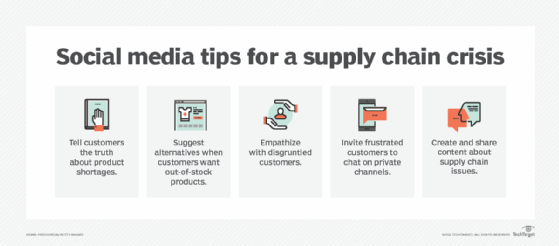
Getty Images/iStockphoto
5 ways to use social media in supply chain management
Amid a supply chain crisis, customers often turn to social media to voice frustration. Organizations need honesty, empathy and informative content to help disgruntled customers.
Supply chain disruptions can frustrate customers, who then turn to social media with questions and complaints.
Amid the COVID-19 pandemic, organizations suffer from various supply chain disruptions, such as low inventory, slow delivery times, material shortages and lack of staff. When customers can't purchase items from brands they like, they may feel a loss of control or ignored. These disruptions can cause customers to ask questions and complain on social media, so organizations must learn to handle these interactions with honesty and empathy.
Customer service agents may feel awkward when they give customers indefinite answers about product availability or shipping schedules. This feeling may intensify when agents respond to customers publicly on social media. Although organizations should tell customers the truth when they don't know a product's availability, some agents turn to corporate jargon and non-answers instead, which customers often dislike. For optimal results, agents should answer supply chain questions with transparency.
Organizations can use the following social media tips when they respond to questions and complaints about supply chain disruptions.
1. Tell the truth
Organizations must tell the truth when customers ask about a product's availability or expected delivery time. If supply chain problems mean an organization doesn't know when it'll restock an item, agents shouldn't respond with optimistic guesses about when the product may arrive. Instead, agents should say they don't know.
For instance, an agent may tweet the following:
"We wish we could tell you when our model 123XYZ dishwasher will be back in stock, but we just don't know. We hope to have that model available within two months."
2. Suggest other products
An upset customer may write a long Facebook post about how they wanted to buy a certain dishwasher model but can't find one within a 500-mile radius. In this situation, customer service teams should suggest another dishwasher that the customer can purchase immediately.
A customer service agent may reply to the Facebook comment with this statement:
"Would you consider a dishwasher with a stainless steel tub? We have plenty of model 456ABC dishwashers in stock. The model 123XYZ dishwasher you were looking at has a plastic tub. The stainless model 456ABC is a little more expensive, but many people prefer stainless, and we have this model available today."
3. Express empathy
When customers rant on social media about conditions an organization cannot change, customer service agents may naturally become defensive. However, they must fight the urge to express anger toward disgruntled customers. In fact, they should express more empathy to these customers than they might normally. When agents empathize, customers feel like they have an ally, even if the agent can't give them what they want.
To express empathy, customer service agents could use the following statements in their social media posts:
"If I were in your situation, I would be asking the same questions."
"I understand how disappointing this is, especially when [paraphrase the customer's perspective or efforts]."
"I can understand why you have followed up on this issue."

4. Move the conversation to a private channel
On social media, one unhappy follower can quickly get hundreds of other followers riled up, so agents should respectfully suggest continuing the conversation through direct messages (DMs). Supply chain problems can last for a long time and frustrate customers, so agents should have these conversations through DMs. These private channels have no character limits and let agents speak with customers away from the broad audience on social media.
Agents should also give the customer a specific reason to DM them. For instance, they could respond with the following:
"Please DM us your order number, so we can follow up with you and provide a delivery date."
"Please DM your account information. We'll look into your payment history and refund you for this back-ordered item."
5. Link to content that explains supply chain issues
Although customer service teams deal directly with customers' tweets and posts, communications teams should develop and regularly update web content to help customers answer difficult questions. With this content, agents can give customers detailed information about product updates.
Organizations should consider the following responses:
"We wish we could give you a firm delivery date for your back-ordered dishwasher, but at this point, we just can't. If you'd prefer to cancel this order, please go to our 'How to Cancel a Back Order' page for instructions at bit.ly/xxxxxxx."
"I'm so sorry your international shipment has been delayed for two weeks. Given current conditions, our shipments are taking about five days longer than normal. Please visit our 'How to Calculate Shipping Time' page for more info at bit.ly/xxxxxxx."
Organizations may want to hide the truth about manufacturing, warehousing and shipping delays, but insincere or evasive social media responses can make matters worse. These responses can generate more customer complaints in the long run and harm brands' reputations. Instead, organizations should use alternative product suggestions, empathy, private channels and informative web content to ease customer frustration.







